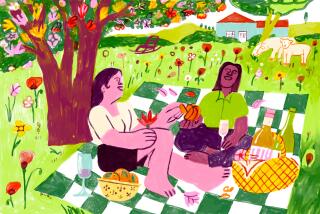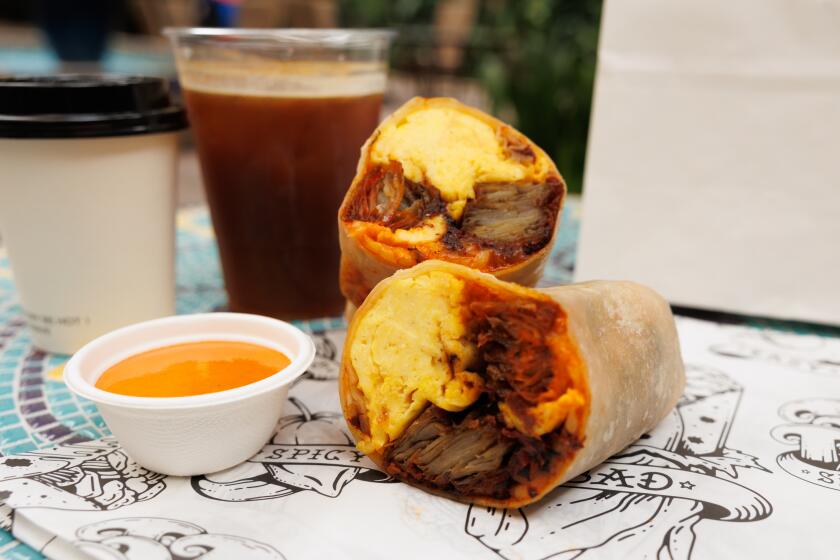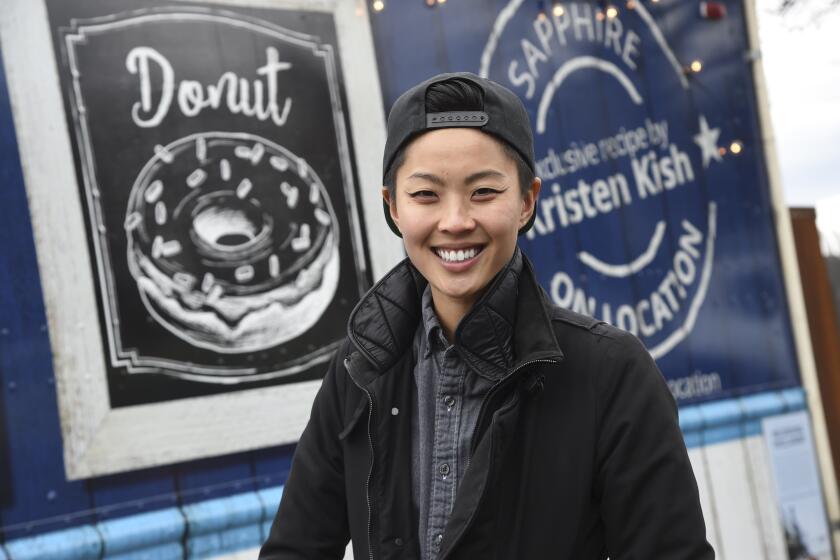A Wild One : Franciscan Winery Goes With Natural Yeasts and Gets Choice Chardonnay
- Share via
THE CREATIVE management at a Napa Valley winery has accomplished something that most others in California have not even attempted. Franciscan Vineyards has managed to make outstanding Chardonnay entirely with wild yeasts.
Nearly all California wines are fermented on selected yeast cultures. In contrast, all French wines are fermented with their own natural yeasts, referred to as “wild” in California.
California wine makers prefer not to use wild yeasts because some strains have been known to cause low levels of alcohol as well as unpleasant flavors and tastes. One such strain produces barnyard scents. Another, brettanomyces , is the worst of these microorganisms because it results in even more malodorous wines.
Yeasts that convert grape juice into wine are usually strains of Saccharomyces cerevisiae var. ellipsoideus , quite simply, the microflora that form the “bloom” on the skin of the clustered berries. These microflora number in the billions. They live in the earth during the winter and are brought to the berries by bees. And they may also inhabit the pores of wooden fermenters and barrels.
Rather than take risks with microflora, California wine makers introduce selected yeast cultures to the musts (the juice pressed from grapes) after all wild yeasts have been inhibited with sulfur dioxide at the time of the crushing. The good single strains of yeast that wine makers add at this point are imported from select regions of Europe.
But single-strain yeasts do not result in complex wines. French enologist J. Renaud concluded in a study of yeast strains in 1939-’40 that wines of fine quality can only be made by relying upon the natural mixed flora of the grapes--that the use of single, selected yeasts tends to produce wines of uniform flavor “without those subtle and valuable differences so much appreciated by the connoisseur.”
“They said it couldn’t be done,” Franciscan wine maker Greg Upton says of a California wine made with wild yeasts. But he dared to use the microflora of his Napa Valley grapes, which were not treated with sulfur, and produced a wine of singular, almost haunting excellence. “Haunting” because it recalls the character of Burgundian Montrachet in significant complexity, of which novelist Alexander Dumas said, “It should be drunk bareheaded and kneeling.”
When I went to Franciscan Vineyards for a recent tasting of the wines, I was surprised to see a huge redwood settee in front of the winery. Everybody hears about “the Rutherford Bench,” a geographic area of the Napa Valley currently prominent because wineries boast of it as the source of their grapes. Its vineyards are treasured slopes because some of the valley’s finest Cabernet Sauvignon vineyards are there. But the boundaries of the Rutherford Bench have not been exactly defined. And Franciscan has playfully installed a well-crafted settee on a cement plinth with a large brass nameplate below it: “The Rutherford Bench.” Now tourists visiting Franciscan Vineyards can sit on “the Rutherford Bench”--probably without having a clue to its inspiration.
At a recent tasting, held at the winery’s guest cottage, the best was saved for last.
We started with the Estancia 1988 Monterey Chardonnay ($7). It is 65% barrel-fermented, with a small amount of the wine undergoing malolactic fermentation. The wine, scheduled for release Nov. 1, spent five months on the lees and is traditionally toasty in taste.
“We are minimalists. We do the least possible to the wines. You might call it ‘hands-off’ wine making,” Upton says.
“We do not buy any grapes. We believe that the true reflection of quality is in the vineyard. With our fixation on vineyards, knowing that the Alexander Valley is outstanding for Cabernet Sauvignon, we removed our Chardonnay, replanted to Cabernet, relocating our Chardonnay sources to a new vineyard in the Arroyo Seco of Monterey County,” Upton says.
Next was the 1988 Estancia Alexander Valley Chardonnay ($7). It’s probably the last edition from Alexander Valley because those grapes are now planted in Monterey County. This wine also spent five months sur lies , giving it a toasty flavor also. And partial malolactic fermentation gives it a buttery richness.
Both Estancia wines are excellent, smooth, rich and fragrant.
Franciscan co-owner Agustin Huneeus was present at the tasting. Since he came aboard in 1984, the once financially troubled winery, with its emphasis on fine traditional wine-making methods, has joined the ranks of the valley’s most successful wineries.
Of the 1987 Chardonnay ($18), Upton says, “We call it ‘Cuvee Sauvage’ because it’s made entirely with wild yeasts, which includes its own malolactic fermentation from natural bacterial microflora.” This first remarkable oak-edged wine had an extraordinary wholeness, a new richness.
The Franciscan 1988 Napa Valley Chardonnay--Cuvee Sauvage followed. The bouquet of this wine is arresting. It is twice as generous as the ’87 and more profoundly striking, with the fruit evident in poetic grace. Here is the finesse of a splendid Montrachet from a fine vintage year, but without a trace of old wood scents that so often mar the perfection of Burgundian wines such as Meursault and Montrachet, both 100% Chardonnay wines. These Franciscan wines are better than many from France.
Franciscan produced only 400 cases of the ’87 vintage, to be released in October. But 1,600 cases were made of the 1988 edition.
A question arises: Will the same multiflora wild yeasts of this 1988 Cuvee Sauvage re-emerge from this Franciscan Oakville vineyard next year?
“We hope so,” Upton says. “The vineyard is now 16 years old--the same soil, same vines; only an unseasonal rain might wash off these microflora. So, it does depend somewhat upon climate, with subtle variations from year to year. It will take years to answer this question.”
The ’88 Cuvee Sauvage is not scheduled for release until February, but it will be more than worth the wait.
More to Read
Eat your way across L.A.
Get our weekly Tasting Notes newsletter for reviews, news and more.
You may occasionally receive promotional content from the Los Angeles Times.










